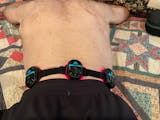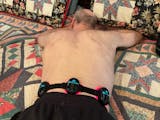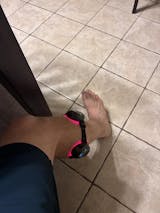A strong lower back is key to improving your overall well-being, especially if you spend long hours sitting or have had previous injuries. Strengthening your lower back can help alleviate pain, prevent future injuries, and support a healthy, active lifestyle. This guide will explore how to safely and effectively strengthen your lower back with exercises, posture adjustments, and
medical-grade red light therapy devices.
Why Strengthening Your Lower Back is Important
Benefits for Posture and Alignment
Strengthening your lower back helps align your spine correctly, which is crucial for maintaining good posture. Good posture reduces strain on your muscles and joints, preventing discomfort and promoting long-term health. Whether sitting, standing, or walking, a strong lower back supports proper alignment throughout your daily activities.
Reducing the Risk of Injury
A well-conditioned lower back provides protection against strains and other injuries. The muscles in your lower back, when strong, act as a support system for your spine and reduce the stress placed on the vertebrae. This can help prevent conditions like herniated discs or sciatica, which are often caused by weak or overused muscles.
Enhanced Mobility and Flexibility
When your lower back is strong, you’ll experience increased mobility and flexibility, making it easier to move freely and comfortably. Strengthening these muscles can prevent stiffness and increase your range of motion, allowing you to perform everyday tasks like bending, lifting, and walking without pain.
Best Exercises to Strengthen Your Lower Back
Deadlifts for Core and Back Strength
Deadlifts are one of the most effective exercises for strengthening both the lower back and the entire core. This compound movement works not only your lower back but also engages your glutes, hamstrings, and core, making it a great full-body workout. Proper form is essential to avoid injury, so focus on keeping your back neutral during the lift.
Bridges for Hip and Lower Back Strength
Bridges are a simple yet effective exercise for strengthening the lower back and glutes. Lie on your back with your knees bent and feet flat on the floor. Lift your hips towards the ceiling, squeezing your glutes as you lift. Hold for a few seconds before lowering. This exercise strengthens the posterior chain, which includes the lower back.
Superman Exercise for Core Stability
The Superman exercise targets both the lower back and the core. Start by lying face down with your arms extended in front of you. Lift your arms and legs off the ground simultaneously, holding the position for a few seconds before lowering. This exercise engages your lower back muscles and helps stabilize your spine.
Bird Dogs for Balance and Core Engagement
Bird dogs are a great way to improve core strength while targeting the lower back. Start on all fours, then extend one arm and the opposite leg simultaneously, keeping your back straight. Hold the position for a few seconds, then return to the starting position. This exercise helps improve stability and engages both the lower back and core muscles.
Posture Adjustments for a Stronger Lower Back
Maintain Proper Sitting Posture
Sitting for extended periods can put a strain on your lower back, especially if you slouch. To avoid this, make sure your feet are flat on the floor, your knees are at a 90-degree angle, and your back is properly supported by your chair. This simple adjustment can relieve pressure and improve spinal alignment.
Adjust Your Workstation Setup
A poorly set up workstation can lead to chronic back pain. Ensure your desk, chair, and computer screen are positioned at comfortable heights. Your computer screen should be at eye level, and your chair should support the natural curve of your spine. Proper ergonomics can make a huge difference in preventing lower back strain.
Standing Desk for Better Alignment
Switching to a standing desk or alternating between sitting and standing throughout the day can alleviate pressure on your lower back. Standing engages different muscles and can reduce the discomfort caused by prolonged sitting. If using a standing desk, make sure your desk is at the correct height to maintain good posture.
The Role of Core Muscles in Lower Back Strength
Why Core Strength Matters
A strong core is essential for a healthy lower back. The muscles in your abdomen, hips, and lower back work together to support the spine. By strengthening your core, you take pressure off the lower back and create a more stable foundation for your entire body. Core strength plays a critical role in maintaining proper posture and reducing lower back pain.
Planks for Core and Back Engagement
Planks are one of the most effective exercises for strengthening the core and lower back. This isometric exercise involves holding a position similar to a push-up, with your body straight from head to heels. Planks engage both the abdominals and lower back muscles, helping to stabilize the spine and improve overall strength.
Side Planks for Oblique and Back Strength
Side planks target the obliques, which are critical for supporting the lower back. Lie on your side, propped up on your elbow, and lift your hips off the floor, holding the position for several seconds. This exercise improves core stability and supports a strong lower back by strengthening the muscles along the sides of your torso.
Using Medical-Grade Red Light Therapy Devices for Recovery
How Red Light Therapy Helps Lower Back Pain
Medical-grade red light therapy devices use specific wavelengths of light to penetrate deep into tissues, promoting healing and reducing inflammation. When applied to the lower back, red light therapy helps alleviate pain, reduces stiffness, and speeds up recovery, making it an excellent complementary treatment to exercises.
The Science Behind Red Light Therapy
FDA approved red light therapy works by stimulating the mitochondria in cells, promoting the production of ATP, the energy molecule that helps with cellular repair. This process reduces inflammation and promotes tissue regeneration in the lower back, easing pain and improving mobility.
Incorporating Red Light Therapy into Your Routine
Incorporating red light therapy into your daily or weekly routine can provide significant benefits for pain relief, skin rejuvenation, and overall well-being. To make the most of red light therapy, here’s a simple guide to follow:

-
Choose the Right Device: Ensure you're using a high-quality
red light therapy device that emits wavelengths between 600-650 nanometers for optimal results.You might want to try the
PRUNGO FluxGo red light therapy device; it might help.
-
Determine Frequency: Start with 3-5 sessions per week. As your body adjusts, you can increase the frequency if needed, but always allow enough recovery time between sessions.
-
Set a Consistent Schedule: Try to use red light therapy at home at the same time each day to establish a routine. This can help you stay consistent and ensure better outcomes.
-
Target Specific Areas: Focus on areas that need treatment, such as painful joints, muscles, or areas showing signs of skin aging. Adjust the distance between the device and the skin based on the manufacturer’s instructions.
-
Be Patient: Results from red light therapy at home may take some time to appear, especially for skin issues or deep tissue pain. Consistency is key, so give it time to work.
By following these simple steps, you can effectively incorporate red light therapy into your routine and start experiencing its benefits.
Nutrition for a Healthy Back
Anti-Inflammatory Foods for Muscle Health
Eating a diet rich in anti-inflammatory foods can help reduce muscle pain and promote healing in your lower back. Foods like fatty fish, leafy greens, and nuts contain omega-3 fatty acids and antioxidants, which help combat inflammation and support muscle recovery.
The Role of Calcium and Vitamin D
Calcium and vitamin D are vital for strong bones, and a healthy spine relies on them. Dairy products, leafy greens, and fortified foods are great sources of these nutrients, which help maintain bone density and reduce the risk of fractures or degenerative conditions in the spine.
Hydration for Muscle Function
Staying hydrated is essential for maintaining muscle function, including the muscles in your lower back. Dehydration can lead to muscle cramps and increased risk of injury. Drink plenty of water throughout the day to keep your muscles functioning at their best.
Lifestyle Habits for Long-Term Lower Back Health
Regular Exercise and Movement
Incorporating regular movement into your daily routine is essential for keeping your lower back strong. Take breaks from sitting, stretch regularly, and engage in low-impact activities like walking or swimming. Keeping your body active helps maintain strength and flexibility, reducing the risk of pain and injury.
Stretching to Improve Flexibility
Incorporating stretching exercises into your routine can keep your lower back muscles flexible and reduce stiffness. Focus on stretches that target the lower back, hamstrings, and hip flexors, as tight muscles in these areas can contribute to lower back pain.
Sleep Positions to Avoid Back Pain
Your sleeping position can have a major impact on your lower back health. Sleeping on your side with a pillow between your knees or on your back with a small cushion under your knees can help maintain spinal alignment and reduce pressure on your lower back.
Conclusion
Strengthening your lower back is crucial for long-term health and well-being. Through regular exercise, maintaining good posture, and using effective treatment tools such as medical-grade red light therapy, you can effectively prevent back pain and improve mobility. If you require extensive treatment, a
red light therapy panel is a good option; while if your goal is facial care, a
red light therapy mask can target multiple facial areas simultaneously, making it particularly suitable for anti-aging, soothing, and repairing. It can also effectively improve skin health, reduce fine lines, even out skin tone, and alleviate acne problems.





















Share:
How Long to Recover from Knee Replacement
How to Relieve Rotator Cuff Pain at Night